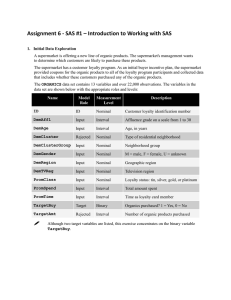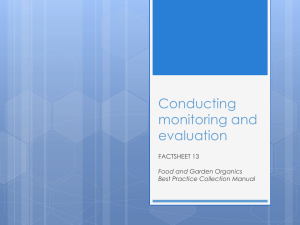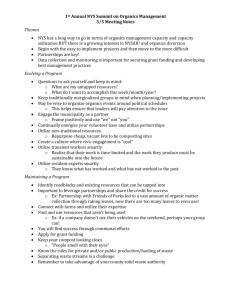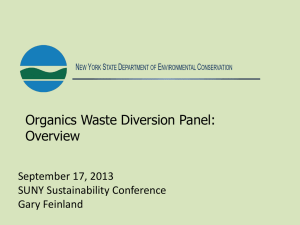Assignment 5 - SAS #2 – Decision Trees
advertisement
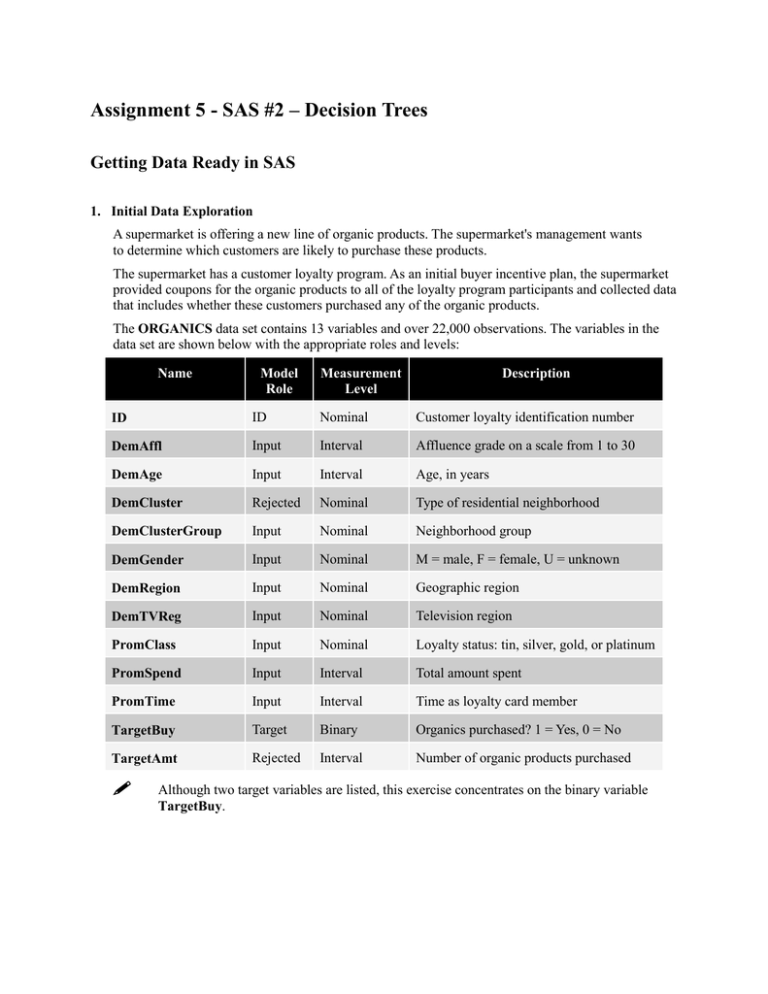
Assignment 5 - SAS #2 – Decision Trees Getting Data Ready in SAS 1. Initial Data Exploration A supermarket is offering a new line of organic products. The supermarket's management wants to determine which customers are likely to purchase these products. The supermarket has a customer loyalty program. As an initial buyer incentive plan, the supermarket provided coupons for the organic products to all of the loyalty program participants and collected data that includes whether these customers purchased any of the organic products. The ORGANICS data set contains 13 variables and over 22,000 observations. The variables in the data set are shown below with the appropriate roles and levels: Name Model Role Measurement Level Description ID ID Nominal Customer loyalty identification number DemAffl Input Interval Affluence grade on a scale from 1 to 30 DemAge Input Interval Age, in years DemCluster Rejected Nominal Type of residential neighborhood DemClusterGroup Input Nominal Neighborhood group DemGender Input Nominal M = male, F = female, U = unknown DemRegion Input Nominal Geographic region DemTVReg Input Nominal Television region PromClass Input Nominal Loyalty status: tin, silver, gold, or platinum PromSpend Input Interval Total amount spent PromTime Input Interval Time as loyalty card member TargetBuy Target Binary Organics purchased? 1 = Yes, 0 = No TargetAmt Rejected Interval Number of organic products purchased Although two target variables are listed, this exercise concentrates on the binary variable TargetBuy. a. Create a new diagram named Organics. b. Define the data set AAEM61.ORGANICS as a data source for the project. 1) Set the roles for the analysis variables as shown above. (You can go back and modify variable roles even after you complete the wizard by rightclicking on the Organics data source and selecting Edit Variables…) The variable DemClusterGroup contains collapsed levels of the variable DemCluster. Presume that, based on previous experience you believe that DemClusterGroup is sufficient for this type of modeling effort. Set the model role for DemCluster to Rejected. 2) Examine the distribution of the target variable TargetBuy. You can do this by clicking on that variable in the Column Metadata (step 6 of 9 in the wizard) and then clicking the Explore button. What is the proportion of individuals who purchased organic products (hint: take a look at the “Sample Statistics” window)? 3) Finish the Organics data source definition. c. Add the AAEM61.ORGANICS data source to the Organics diagram workspace. Decision Trees You’ll be working on the project you just. Remember, this project used the “Organics” data set. When you open SAS Enterprise Miner, you should be able to find your work under the File/Recent Projects. If you can’t find it there, go to File/Open Projects… and search for your project. Create a Decision Tree based on the Organics Data Set 2. Add a Data Partition node to the diagram and connect it to the Data Source node. Assign 50% of the data for training and 50% for validation. Run it. Add a Decision Tree node to the workspace and connect it to the Data Partition node. 3. Create a decision tree model autonomously (i.e., just run the Decision Tree node). Answer the two questions below and attach the screenshot(s) in your solution document where you found the answer. 1) How many leaves are in the optimal tree? 2) Which variable was used for the first split? 4. Add a second Decision Tree node to the diagram and connect it to the Data Partition node. In the Properties panel of the new Decision Tree node, change the maximum number of branches from a node to 3 to allow for three-way splits. Create a decision tree model using average square error as the model assessment statistic. Answer the two questions below and attach the screenshot(s) in your solution document where you found the answer. 1) How many leaves are in the optimal tree? (HINT: In your iteration plot, you can click near the “Number of leaves” label and drag right to zoom in) 2) Based on average square error, which of the decision two tree models appears to be better (the first one or the second one)? <<GO TO THE NEXT PAGE!!>> 2. Start at the top of the decision tree and work your way downwards to answer the following questions (you don’t need to include screen shots for these questions – just provide the answer): Question What is the probability that a 33 year old man with affluence grade 10 buys Organics? What is the probability that a 23 year old woman with affluence grade 3 buys Organics? What is the probability that a 55 year old man with affluence grade 6 buys Organics? What is the probability that a 64 year old woman with affluence grade 4 buys Organics? What is the probability that a 65 year old woman with affluence grade 20 buys Organics? Answer
